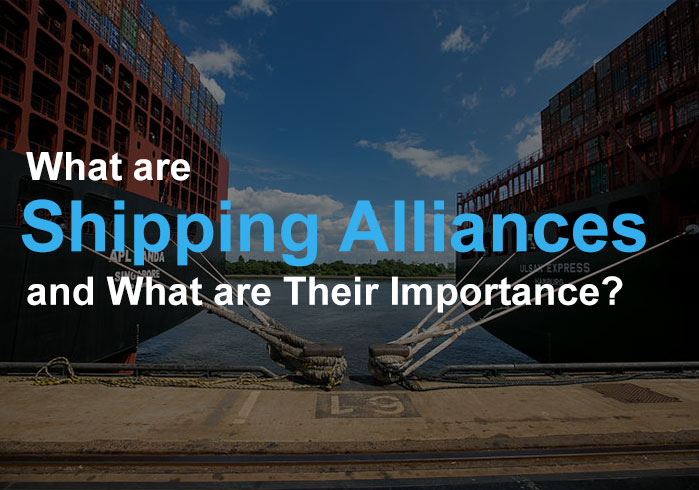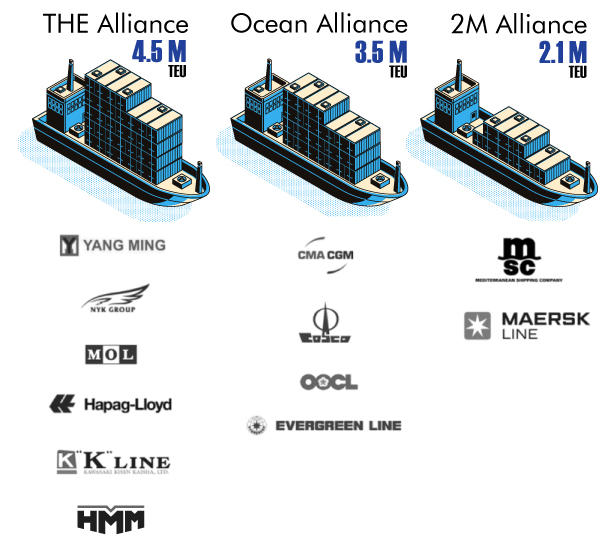Carriers know that business operations can be tight, especially when it comes to the variable operational costs. But, that doesn’t mean that shippers can’t help one another, and this is the case with the three major shipping alliances that operate on a global scale. These alliances are continuing to expand, adding new members, and thus disseminating the benefits of being part of a shipping alliance to an increased number of carriers and, subsequently, their customers. But what are exactly these Shipping Alliances?
Shipping Alliances: What are they?
A Shipping alliance, more commonly called ocean alliance, represents a type of cooperative agreement among ocean carriers that serves as a strategic alliance to cover different trade routes thanks to the cooperation of various members on a global scale.
In other words, a shipping alliance is a group of shippers who have aligned together for common goals in a way that benefits everyone, not just the carriers themselves, but also the customers by obtaining better rates, routes, and transit times for their shipments.
But, Why are shipping alliances important in global trade?
Shipping alliances are beneficial to everyone involved, from the big carriers who start the alliances down to smaller shippers who benefit from the perks alliances offer. They are essential when it comes to negotiating on behalf of shippers everywhere all around the world for various trade routes.
These types of alliances are incredibly important when you consider that the operational cost for a shipping account represents over 67% of the total cost of running that operation. From this 67%, 46% relates to bunker costs, with the remaining 21% related to port charges. Both of these costs are variable and can fluctuate at any time. Shipping lines under harsh economic conditions are unable to provide service coverage alone without their ships being tied up on a specific route for weeks on end leaving other routes unserviced. But, this is where shipping alliances come into play.
Shipping alliances help to reduce these variable costs through the usage of shared resources like networks, port terminals, and ships along specific routes. With such alliances, larger shipping lines can utilize the resources of all members. In contrast, smaller lines can capitalize upon that extended service coverage and resources without investing in an increase in fleet size.
What benefits shipping alliances offer for shippers?
Shipping alliances have brought Mega ships and mega ports benefits in the form of better allocation of resources, reduced operational costs, expansion of service coverage, and optimization at all levels, which in the end contributes to better economies of scale. This is something that can be felt in larger companies who take advantage of every single major trade route around the world, as well as middle-of-the-road shippers, all the way down to smaller shippers who are using just one of the multiple international trade routes.
Three significant alliances dominate the world of global trade today: The Transport High Efficiency Alliance or “THE Alliance” is first, followed by the “Ocean Alliance”, and the “2M Alliance”.
All three of these are not only significant in size with multiple members, but they control a great deal of volume (77.2% of global container capacity and 96% of all East-West trades’ container capacity) which means they have a lot of negotiation power and can put pressure on different ports to create more favorable conditions for all members of the alliance. This bargaining power leads to better tariffs and higher volume discounts, which enables everyone involved to remain competitive. Moreover, these cost-savings can be passed along to their customers.
Variable operational costs are often subject to significant changes based on shifts in the economy or the political climate in different regions where shipping lanes intersect. But, having large groups to fight on behalf of shippers everywhere helps to rain in these otherwise out of control changes to variable operating costs and, as such, have proven to be beneficial for all members.
Changes to the alliances in 2020
As of 2020, HMM (Hyundai Merchant Marine) will be a new member of THE Alliance (Yang Ming, Hapag-Lloyd, and Ocean Network Express) adding 12 new 23,000-TEU mega-ships to the agreement. This revised alliance will expand the services available between Asia and North Europe extending the rotation of vessels to 12 weeks, adding calls throughout Asia and Europe, including Busan in Korea and Spain, which will allow carriers to load cargo along the Asia Mediterranean loop as well.
The Ocean Alliance (CMA CGM/APL, Cosco Shipping/OOCL, and Evergreen Line) will be applying minimal changes to its service network for 2020, like implementing its “Day 4” schedule in April, promising more port calls, more direct links, and better transit times. Another significant change coming to the alliances in 2020 is an increase in the services offered, including the services connecting Asia to North Europe, Asia to the Mediterranean, and Asia to the Middle East. The Ocean Alliance remains highly stable compared to its rival alliances, both of which will adjust their services to accommodate any gains or losses of HMM.
These increases among the different alliances mean that import volume is going to shift heavily, and options for alliance members will continue to expand well into 2020.
The 2M alliance has not announced any changes as of yet, but with HMM now joining THE Alliance, their US volume previously carried in slot swaps between both 2M Alliance members will shift hands and will require the 2M to adjust for the loss of Trans-Pacific shipments.
Conclusion
Overall, shipping alliances have proven themselves to be a very effective way for shipping companies, both large and small, to come together and share resources. They bring about benefits for all involved and allow large shipping companies to fight on behalf of smaller shipping companies.
The strategic importance of such alliances will continue well into 2020 as figures stipulate that more ships are joining these alliances, and more alliances are reporting steady figures. They are not impacted by variable costs to the same degree as individual shipping companies. All of this points toward a significant change over the coming years as more shippers, including large shipping companies, get involved in these strategic partnerships to control their otherwise variable and fluctuating costs.







8 Comments on “What are Shipping Alliances and What are Their Importance?”
Very good document, updated and easy to understand.
Very good document, updated and easy to understand.
Very good document, updated and easy to understand.
There seems to be a small confusion by the author when using concept of “shipper” which is not referred to the reality of its authentic definition.
Shipper supposed to be the concept of the one who owning the cargo and demanding for the space which is provided by the Ocean Carrier.
By this meaning, Shipper could be either an Exporter/Seller (in the condition of CNF by incoterm) or Importer/Buyer (in case of FOB, also known as Consignee). They, in no case, can not be legitimated as a transporter/carrier
These Alliances have been strategically designed since 2014 and their main objectives is to cut cost and make profit. It smells pretty good. They have gained our trust throughout the years and suddenly the ghost jumped out of the Alliance Boxes…. The whole world has fed a Monster who start sucking everyone blood. The freight rate has jumped significantly high that everyone start to realise the true objective of the alliances. They have been making excessive profits during and after the pandemic. They will continue to do unless there is quick intervention from Governments throughout the world. During the pandemic we at least know that there is an invisible enemy in our midst , but , our real enemy is the ALLIANCE who is profiting of the situation
These increases among the different alliances mean that import volume is going to shift heavily, and options for alliance members will continue to expand well into 2020.
Thanks for sharing this post with us very informative post very good document, updated, and easy to understand.
A Shipping alliance, more commonly called ocean alliance, represents a type of cooperative agreement among ocean carriers that serves as a strategic alliance to cover different trade routes thanks to the cooperation of various members on a global scale.